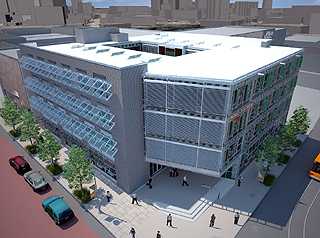
DJC.COM
February 22, 2007
Green office building goes back to the future
Weber + Thompson

Thompson
|
For a building that will be one of the West Coast’s most energy-efficient, the Terry Avenue office building is mostly low-tech, at least from a heating, cooling and lighting standpoint. And that’s fine with us.
The project — a First Western Development project that Rafn Co. is now constructing — is Seattle’s first substantial modern office building without air conditioning in half a century. This and other design elements will substantially reduce operating expenses.
In fact, we calculate that the 40,000-square-foot building, located on the corner of Terry Avenue and Thomas Street in South Lake Union, will consume 30 percent less energy than a traditional office project of a similar size.
Passive design strategies can have a significant effect on energy performance. Orientation, shape and natural lighting are critical components of a successful sustainable structure.
To promote natural ventilation and lighting, the design evolved into an open-air court scheme, with the building entrance at the corner. The four-level structure wraps around a court with floor plates that are 35 feet deep — narrow by current office standards.

Image courtesy of Weber + Thompson Weber + Thompson’s Terry Avenue office building is designed to consume 30 percent less energy than a traditional office project of a similar size. |
Operable windows and vents along all the facades will promote good air flow as the hot air collects in the courtyard and rises, creating a cross breeze inside.
The system’s heart is the central courtyard. This semipublic/private open space will be the common outdoor gathering area for the building’s occupants, with grade-related retail spilling out onto the sidewalk.
Ideal climate
The thought of a new building without air conditioning in an ever-warming world might cause some to dismiss the project as unrealistic. We beg to differ.
Most commercial buildings constructed prior to mid-century were designed based on these simple principles.
With our temperate climate and relatively low humidity, the Northwest is ideal for passively cooled structures. Extensive thermal modeling conducted by Stantec Engineering concluded that there may be only 18 to 20 hours a year when the temperature will climb above 80 degrees inside.
Because the benefits of fresh air, natural light and control over personal work environments were staff priorities early on in the design process, we decided that the inconvenience of a few warm afternoons a year is something we can live with. This will be a building where we will actively participate in the comfort levels of our workplace, much like we do at home.
In addition, each exterior facade was designed as a response to its exposure. Fixed sunshades, or “sunglasses,” will be attached on the east and west sides, and operable exterior mechanical louvers will be hung on the northeast angled facade and in the interior court.
Green features
The structure will be steel frame and fly-ash concrete construction with an integrated aluminum commercial window wall system on the exterior. All components will contain a large percentage of recycled materials, and the roof will be a light PVC membrane for reflectance.
Daylighting models were tested extensively at the University of Washington’s Daylighting Lab to ensure even lighting throughout the interior.
Other sustainable features in the Terry Avenue office building are low-flow plumbing fixtures, waterless urinals, a highly efficient hot-water heating system and perimeter hydronic radiant heating that is individually controlled. With only one elevator, the use of stairs will be encouraged by making them visible and accessible to users and visitors.
The exposed structure minimizes the use of finish materials, and good indoor-air quality will be achieved by using low-VOC paints, adhesives and carpet.
Additionally, the South Lake Union streetcar will run directly in front of the building, encouraging all of us to stay out of our automobiles. The corner of Terry Avenue and Thomas Street will be a special urban place where pedestrians, low-intensity traffic and public transit will intertwine.
The Terry Avenue office building will be completed in March 2008, and we anticipate LEED gold core and shell certification.
Our goal is to construct a place that promotes a healthier environment by using energy, water and other natural resources more efficiently, which, in turn, will reduce our impact on the environment.
A sustainable building uses design and technology that works with nature. It promotes a sense of community, a sense of place. This vision is at the core of our practice.
Scott E. Thompson, AIA, is a founding principal of Seattle-based Weber + Thompson, a full-service, West Coast design firm specializing in architecture, interior design and planning.
Other Stories:
- How much energy are you really saving?
- Let technology play a role in your green building
- Will more cash now mean big savings later?
- Snowboarding can teach us how to be green
- Can buildings be free of fossil fuels by 2030?
- My house is greener than your house
- A platinum LEED rating — how we did it
Copyright ©2009 Seattle Daily Journal and DJC.COM.
Comments? Questions? Contact us.